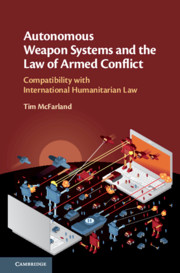 Autonomous Weapon Systems and the Law of Armed Conflict
Autonomous Weapon Systems and the Law of Armed Conflict Book contents
- Autonomous Weapon Systems and the Law of Armed Conflict
- Autonomous Weapon Systems and the Law of Armed Conflict
- Copyright page
- Contents
- Figures and Tables
- Acknowledgements
- 1 Introduction
- 2 Legal Background
- 3 Understanding Weapon Autonomy
- 4 Identifying Legal Issues
- 5 Weapons Law
- 6 Targeting Law
- 7 Accountability
- 8 Recommendations
- Index
3 - Understanding Weapon Autonomy
Published online by Cambridge University Press: 17 June 2020
- Autonomous Weapon Systems and the Law of Armed Conflict
- Autonomous Weapon Systems and the Law of Armed Conflict
- Copyright page
- Contents
- Figures and Tables
- Acknowledgements
- 1 Introduction
- 2 Legal Background
- 3 Understanding Weapon Autonomy
- 4 Identifying Legal Issues
- 5 Weapons Law
- 6 Targeting Law
- 7 Accountability
- 8 Recommendations
- Index
Summary
This chapter consists of two parts. The first part covers basic aspects of machine autonomy as a technical concept, explaining how it constitutes a form of control over a machine and how degrees of autonomous capability manifest in complex machines. This part is not about weapon systems in particular, but about electromechanical systems in general. It briefly outlines adaptive and intelligent control methodologies and explains that autonomy does not sever the connection between a machine and its operator but only alters the relationship between them. The second part discusses some aspects of how autonomous systems are used in military applications. Specifically, autonomous behaviour will extend to systems ancillary to combat operations and autonomous systems will be employed in roles wherein they effectively ‘collaborate’ with human soldiers and with each other. Assessing the legal consequences of using autonomous systems in military operations is therefore not simply a matter of studying the properties of a new type of weapon; it is about understanding a new relationship between soldiers and weapons.
Keywords
- Type
- Chapter
- Information
- Autonomous Weapon Systems and the Law of Armed ConflictCompatibility with International Humanitarian Law, pp. 28 - 56Publisher: Cambridge University PressPrint publication year: 2020
